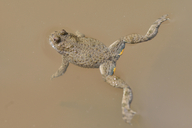|
Bombina variegata (Linnaeus, 1758)
Yellow-Bellied Toad | family: Bombinatoridae genus: Bombina |
 © 2021 Benjamin Monod-Broca (1 of 95) |
|
|
|
Description Distribution and Habitat Country distribution from AmphibiaWeb's database: Austria, Belgium, Bulgaria, Czech Republic, France, Germany, Greece, Hungary, Italy, Liechtenstein, Luxembourg, Macedonia, the Former Yugoslav Republic of, Moldova, Republic of, Montenegro, Netherlands, Poland, Romania, Serbia, Slovakia, Slovenia, Switzerland, Ukraine
There is a contact zone with the related species, the Fire-Bellied Toad (Bombina bombina). This zone extends over the Southern Poland, Czech Republic, Austria, Hungary, Bulgaria, Romania, Yugoslavia, Greece and Western Ukraine. Bombina variegata lives mainly in foothills and mountains: in coniferous, deciduous and mixed forests, bushlands and meadows, floodplains, grasslands etc. At low elevations the toad lives in deciduous forests whereas in highlands it inhabits coniferous forests, highland glades and the upper forest margins. It uses various types of water bodies, including lakes, ponds, swamps, rivers and stream pools (sometimes streams with swift current), springs etc. Its requirements to water quality are relatively low. The toad occurs even in highly polluted wetlands, even waters with high concentrations of hydrogen sulfide and salts. Life History, Abundance, Activity, and Special Behaviors Hibernation begins at the end of September - beginning of October and ends in March - May, depending on elevation. The toads overwinter in burrows, holes under stones and logs. In thermal springs, the toads may be active in winter. Reproduction starts 5-10 days after entering the water and extends to August. Amplexus is pelvic. Amplectant specimens and the spawn are often observed at the same time and in wetlands where conspecific tadpoles undergo their metamorphosis. Along with a wide diversity of breeding pool types, this trait increases the variety of habitats used by the toad populations. Sometimes heavy rains in summer may be followed by intensive spawning of B. variegata in small wetlands. The male mating call is similar to that of B. bombina, but is quieter and higher. The clutch consists of 45-100 (or more) eggs deposited in portions. In contrast to B. bombina, the Yellow-Bellied Toad eats mainly terrestrial arthropods. This composition of diet corresponds with its more terrestrial habits. Aquatic invertebrates, e.g. Gammaridae, are eaten mostly on the stream banks. The diet changes with age during the postmetamorphic period of life and includes an increase in the selection of larger prey. However, no age changes are known in the proportions of aquatic and terrestrial prey in the diet. Trends and Threats Relation to Humans Possible reasons for amphibian decline Urbanization Comments Some amphibians are able to persist in human-modified habitats, including within cities and intensively managed lands. Which mechanisms allow persistence in such environments? Cayuela et al. (2022) conducted a comprehensive analysis of mark-recapture studies of Yellow-bellied Toad (Bombina variegata) populations across a range of anthropic habitats. These toads breed in early-succession ponds and small pools of natural or anthropic origin. Life history traits can change along the gradient from natural to anthropic habitats according to two demographic scenarios. In the first scenario, the risk of adult mortality decreases with anthropization, associated with concomitant decreases in predation and parasitism rates. In the alternative scenario, increased exposure to contaminants, invasive species, ecological mismatches and other processes promote higher adult mortality risk in human-modified habitats. In this scenario, increased recruitment can compensate for increased adult mortality. Cayuela and collaborators estimated adult recruitment, adult survival, lifespan, and senescence rate from 67 populations of the yellow-bellied toads across western Europe. They convincingly show that toads in anthropogenic habitats have lower adult survival, shorter lifespan, and accelerated senescence than toads in natural habitats. Compensatory recruitment indeed occurs in anthropogenic habitats, where average adult recruitment is 93% higher than in natural habitats. Increased human land disturbance might promote creation of breeding habitats conducive to higher adult recruitment. These findings suggest the important role of human disturbance for maintaining populations of amphibians using early-succession habitats. (Written by A. Catenazzi)
References
Bannikov, A. G., Darevsky, I. S. and Rustamov, A. K. (1971). Zemnovodnye i Presmykayushchienya SSSR [Amphibians and Reptiles of the USSR]. Izdatelistvo Misl, Moscow. Bannikov, A. G., Darevsky, I. S., Ishchenko, V. G., Rustamov, A. K., and Szczerbak, N. N. (1977). Opredelitel Zemnovodnykh i Presmykayushchikhsya Fauny SSSR [Guide to Amphibians and Reptiles of the USSR Fauna]. Prosveshchenie, Moscow. Gasc, J. P. , Cabela, A., Crnobrnja-Isailovic, J., Dolmen, D., Grossenbacher,K., Haffner, P., Lescure, J., Martens, H., Martinez Rica, J. P.,Maurin, H., Oliveira, M. E., Sofianidou, T. S., Vaith, M., and Zuiderwijk, A. (1997). Atlas of Amphibians and Reptiles in Europe. Societas Europaea Herpetologica and Muséum National d’Histoire Naturelle, Paris. Kuzmin, S. L. (1995). Die Amphibien Russlands und angrenzender Gebiete. Westarp Wissenschaften, Magdeburg. Kuzmin, S. L. (1999). The Amphibians of the Former Soviet Union. Pensoft, Sofia-Moscow. Nöllert, A. (1996). ''Verbreitung, Ökologie und Schutz der Gelbbauchunke.'' Naturschutzreport, 11(1), 1-260. Nöllert, A. and Nöllert, C. (1992). Die Amphibien Europas. Franckh-Kosmos Verlags-GmbH and Company, Stuttgart. Szczerbak, N. N. and Szczerban, M. I. (1980). Zemnovodnye i Presmykayushchiesya Ukrainskikh Karpat [Amphibians and Reptiles of Ukrainian Carpathians]. Naukova Dumka, Kiev. Originally submitted by: Sergius L. Kuzmin (first posted 1999-09-29) Edited by: Kellie Whittaker, Michelle S. Koo (2023-01-29) Species Account Citation: AmphibiaWeb 2023 Bombina variegata: Yellow-Bellied Toad <https://amphibiaweb.org/species/2046> University of California, Berkeley, CA, USA. Accessed Nov 24, 2024.
Feedback or comments about this page.
Citation: AmphibiaWeb. 2024. <https://amphibiaweb.org> University of California, Berkeley, CA, USA. Accessed 24 Nov 2024. AmphibiaWeb's policy on data use. |




 Map of Life
Map of Life